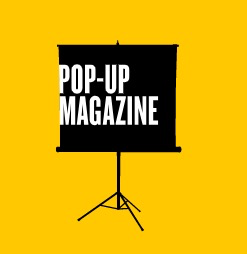Pop-Up Magazine. Live. Unplugged and in 3-D. | KQED Arts

Print may soon be approaching The End Times, but quality journalism is still popping up, if you know where to look.
One place is Pop-Up Magazine, an occasional periodical printed without ink or binary digits. It’s a live magazine that unfolds on stage in front of a live audience and features all the goodies that good magazines offer — front-of-the-book, the Q&A, great photography, an eclectic array of feature stories, presented by esteemed writers, artists, and filmmakers. Followed by drinks.
It’s journalism unplugged. Here content — not clickability — is king.
The magazine’s third issue hits the stage on April 16. It won’t be followed by a print edition. If you miss it, you can’t read the transcript or watch the video online. “It’s a show purely for the people in the room,” said Douglas McGray, the magazine’s Editor-In-Chief.
McGray and his small staff are committed to keeping the show off-line. “We love the Internet, we love technology, but we also feel that everything is instantly documented and sliced up and distributed [online] whether or not it really fits the medium of a web browser.” McGray believes that there’s little consideration of how well-suited the content is to the medium. “It’s just: put it online because it’s free.”
But Pop-Up Magazine, he says, is not a reaction to online content. “I don’t think Pop-Up is a big comment on the state of media so much as it is a smaller comment on how infrequently the different genres mix together,” said McGray, who writes for magazines like The New Yorker, The New York Times Magazine, and The Atlantic Monthly and contributes to This American Life.
“Writers have their literary events and documentary filmmakers have their screenings and radio people go to Third Coast and artists have their gallery openings,” said McGray. He wondered, “why do all these events have to be so segregated?” Pop-Up Magazine strives to roll all of this into one festive happening.
To this end, the current issue will juxtapose food activist Bryant Terry with architecture critic Chris Hawthorne, Joe Richman, creator of Radio Diaries on NPR with gadget guy Steven Leckart. Oscar-winning filmmakers Rob Epstein and Jeffrey Friedman will show parts of their forthcoming film HOWL. Other contributors are writers from Mother Jones, The Times Magazine, Wired and The New Yorker.
The composition is anything but haphazard. McGray describes it as akin to an old fashioned mix-tape where there’s a certain art in figuring out what flows well into something else.
Pop-Up Magazine joins storytelling and interview mainstays like City Arts and Lectures and New York’s The Moth, which is “the granddaddy of them all,” according to McGray. It’s a reading series of personal stories built around a theme. As is Porchlight in San Francisco. Their next event, on April 19, is called “The Last Taboo: Stories About Money.”
But of late there are some newer additions such as The Monthly Rumpus, an iteration of the online magazine The Rumpus. Literary Death Match (next one is on April 9 at The Elbo Room) presents humor-focused readings with a Def Poetry Jam meets American Idol vibe.
No doubt, the developing interest in live events such as these is connected with the growth of life online. The web is a great place to communicate and share, said McGray, but “it makes sense that there are people who also want to go out and do things too.”
So Pop-Up Magazine will remain resolutely off-line. “You have to go, or you missed it,” said McGray. “It’s not the end of world if you missed it. I’d like to think it’s sad.”
Pop-Up 3 is Friday, April 16, 2010, 8pm at the Herbst Theater in San Francisco. For tickets and information visit popupmagazine.com.
Source: Pop-Up Magazine. Live. Unplugged and in 3-D. | KQED Arts